| Published
on 15
Oct 2018 |
All rights reserved.
|
|
|
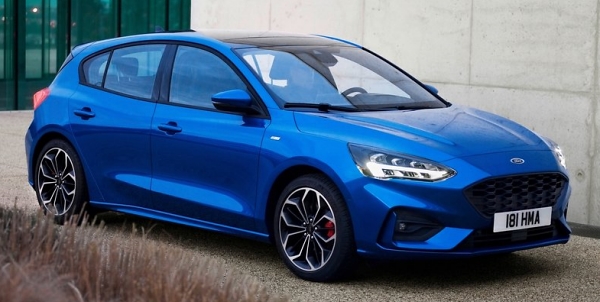
|
|
Ford
Focus returns to form
|
|
20 years ago, Ford
replaced it long-serving, boring and mediocre Escort with a
groundbreaking new car called Focus. It featured a striking design, a
spacious cabin and an innovative “Control-blade” independent rear
suspension, among others. Not only setting new standards in handling
and ride, it was once the best-selling car in the world. However, the
Focus magic was lost in the second and third generation. While they
retained mostly the driving dynamics, they failed to lift the bars.
They got uglier, heavier and they stopped innovating, too. As a result,
it was surpassed by the very best Volkswagen Golf and many other rivals.
The new, 4th generation Focus seems capable to change this trend. I
won’t say it could match the greatness of the original Focus – no, it
still lacks that wow factor and innovating mind – but it seems to have
the faults of the last two generations corrected, putting the Focus
nameplate back to the right path. This starts from a more interesting
exterior design. You might find it has some flavours of Alfa Romeo
Giulietta and Mazda 3, but its proportion looks lighter and healthier
than the Mk3. Its flowing waistline looks more dynamic than the
straight line of the old car. Ditto the curvy fenders. The windscreen
is set more upright and the bonnet is stretched. Rear quarter windows
are now part of the rear doors so to enable larger door apertures and
by the way makes the cabin airier. There are different trims, i.e.
Titanium (mainstream), ST-Line (sport), Vignale (luxury) and Active
(crossover pretended), and each get different front-end styling. Its
drag coefficient is only 0.273, thanks to efforts like active shutter
grille and some underbody panels.
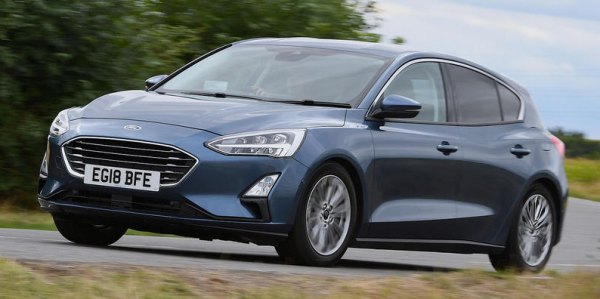
|
|
You
might find it has some flavours of Alfa Romeo Giulietta and Mazda 3,
but its proportion looks lighter and healthier than the Mk3.
|
|
At 4378mm, the new car is only 20mm longer than before, but its
wheelbase has been stretched by 53mm to a generous 2701mm. The body
width is reduced by 3mm while height is cut by 15mm, so its frontal
area should be reduced slightly, which helps fuel economy, too.
Speaking of the latter, Ford claims a reduction of about 12 percent in
average. The extended wheelbase yields 56mm more rear knee room, while
shoulder room is enhanced by 60mm. The middle rear passenger is also
benefited from a flat floor (this means there won't be 4WD version –
rumours said the next RS will use GKN's electrical rear axle, so
getting rid of transmission tunnel is a logical move). In terms of
accommodation, the new Focus has been lifted from near bottom of the
class to one of the roomiest.
The new car sits on the new C2 platform. Predictably, it is lighter by
employing more high-strength steel and aluminum front crash structure.
The monocoque chassis is 33kg lighter yet 20 percent stiffer
torsionally (or 50 percent stiffer around the suspension mountings). In
addition to savings in body panels (25kg), interior (17kg), powertrain
(6kg) and electrical system (7kg), the whole car is about 50kg lighter.
That said, it is slightly heavier than VW Golf and Peugeot 308.
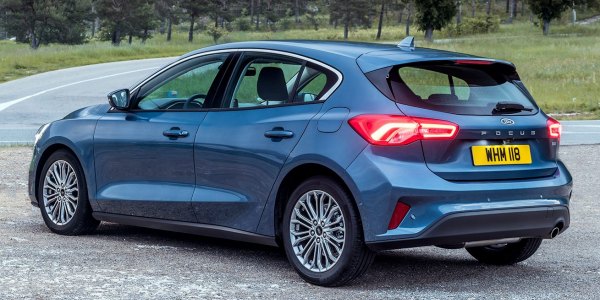 |
|
It
follows the strategy of Volkswagen to downgrade the cooking models to a
simple torsion-beam axle.
|
|
Not so excited is the new rear suspension. It follows the strategy of
Volkswagen to downgrade the cooking models to a simple torsion-beam
axle. Ford claims that handling is not affected, thanks to the stiffer
chassis and a torsion-beam design learned from Fiesta ST, although it
admits bump absorption on potholes will suffer a little bit inevitably.
Independent rear suspension is kept for high-power models (1.5 petrol
and diesel), but it has been changed to an unequal-length
double-wishbone setup. Continuously adaptive damping is optional to the
IRS models but unlikely to be popular. The suspension of ST-Line is set
10mm lower, stiffer and comes with harder bushings. It is promised to
offer keener lift-off oversteer.
The engine range comprises of only 3-cylinder Ecoboost petrol and
4-cylinder turbo diesel. The 1.5-liter diesel (95hp or 120hp) and
2.0-liter diesel (150hp) are just a development from the old units thus
there is no way to stop their sales declining in the current
atmosphere. The petrol triples are expected to take more sales. Most
people will choose among the 85hp, 100hp and 125hp version of the
1.0-liter Ecoboost, while those demanding more performance will opt for
the 1.5-liter Ecoboost with either 150hp or 182hp. All these triples
get cylinder deactivation, a new cylinder head and higher injection
pressure for efficiency improvement. They mate to 6-speed manual
gearbox or a new 8-speed automatic (probably from Aisin). The top 182hp
1.5 Ecoboost engine with manual box can propel the car from rest to 60
mph in 8 seconds, good for a family car but not qualify for a warm
hatch. Rumours said the new Focus ST will be powered by a detuned
version of the old RS' 2.3-liter turbo, but it is yet to be confirmed.
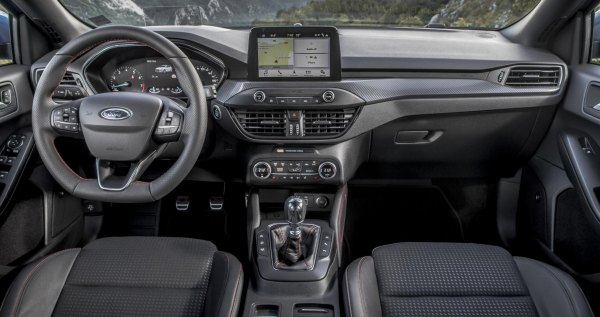
|
|
A
lot more spacious, but design and build quality do not live up to
expectation.
|
|
So how does it feel like on the road? The cabin is spacious all round,
thanks in part to pushing the dashboard forward. Visibility is good and
the ambience is airy. The controls have been simplified, reducing the
number of buttons as some functions have been put to the touchscreen,
but thankfully it leaves the audio and air-con knobs for easier access.
Unfortunately, Ford’s interior designers still do one of the worst jobs
in the industry. The dashboard looks quite old-fashioned and
unattractive. While materials have been improved to match class
standards, it is noticeably cheaper than Volkswagen or Peugeot. Most
plastics you touch frequently are soft, but the door handles are hard,
and the trim materials vary inconsistently. On the plus side,
the Sync3 infotainment system saves the game with its crisped graphics
and intuitive software.
Despite losing a cylinder, the 1.5-liter Ecoboost 3-pot engine does not
disappoint, for it is smooth and quiet yet reasonably powerful. There
is not much turbo lag to detect, and the exhaust note is more
characterful than a typical 4-cylinder. The 1-liter Ecoboost with 125hp
naturally feels weaker, in particular below 2000 rpm, but it still
offers a flexible mid-range and the same uncannily smoothness and
refinement. Meanwhile, the manual gearbox has a long throw but its
gearshift is slick, beating those of Volkswagen and most rivals.
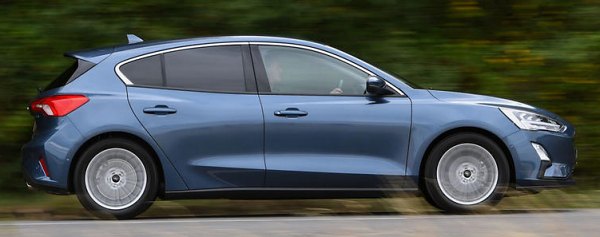
|
|
It
tackles twisty roads with an agility and eagerness rare in the class,
yet absorbent.
|
|
As for handling and ride, fans won’t be disappointed. The 1.5 ST-Line
with independent rear suspension easily tops the class with a supple
ride, tidy control and expert balance. Its electrical power steering is
not as feelsome as old-school hydraulic steering, but communicative
enough to shame rivals. It is also linear, highly precise and well
weighted, giving you confidence to lean on. However, even the cooking
models with 1-liter motor, twist-beam and soft suspension setup is good
enough to beat a Golf or a brand-new Kia Ceed with multi-link rear
axle. It tackles twisty roads with an agility and eagerness rare in the
class – only Mazda 3 is comparable, but it is more absorbent and
quieter than the Mazda. Unlike most cars in the class, its chassis has
a neutral balance rather than set to safe understeer. This means you
can induce a bit oversteer on lift-off to sharpen its cornering. The
softer suspension setup lacks the ST-Line’s sharper responses and
tighter body control, but it lets the cheaper suspension to absorb
bumps and damp undulations nearly as good as the double-wishbone setup.
The only compromise is high-speed refinement, where it never truly
settles on small irregularities. This means it is not as comfortable as
a Golf when cruising on highway. On the plus side, the Focus has tire
and wind noise better insulated than the VW. In short, the cooking
Focus blends driving fun with comfort better than others, whereas the
1.5 ST-Line is better still in both respects.
After the underachieving Mk2 and Mk3, the Mk4 Focus is back to form. Is
it good enough to beat VW Golf? It depends on your priority. Whereas
the Ford has stronger dynamics and more space, the VW has a noticeably
higher quality interior and a more tasteful look outside, yet it
performs well enough in all other areas. I think most buyers may prefer
the rounded, premium-feeling VW – a great achievement for a 6-year-old
model, while keen drivers will prefer the 1.5 ST-Line Focus.
|
Verdict:      |
Published
on 5
Apr 2020
|
All rights reserved.
|
|
Focus ST
|
|
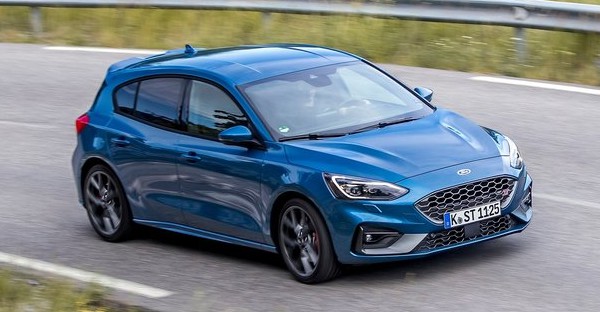
|
|
Focus
ST returns with a larger engine, eLSD and adaptive dampers. Can it beat
Civic Type R?
|
|
The
market positioning of Focus ST has always been embarrassing. It is not
supposed to be as hardcore as the top-tier hot hatches like Civic Type
R or Megane RS, but it is not as refined or well-rounded as a Golf GTI
either. However, at least the last Focus ST was a bargain. When it went
on sale in 2012, it started at just £23,000. The same cannot be
said to the new, 4th generation Focus ST, which starts at
£32,000, matching the class-leading Civic Type R and exceeding
Megane RS. It is also significantly more expensive than the
surprisingly capable Hyundai i30N. Is it good enough to justify the
price hike?
Behind that aggressive mesh grille sits a large four-cylinder engine.
It displaces 2.3 liters and comes straight from Ford Mustang, or you
may describe it as a detuned version of that serving the last
generation Focus RS. Most
rivals employ 2.0-liter motors and Renault even uses 1.8.
Comparatively, Ford’s
2.3-liter engine is not very efficient, producing a class-average
280hp which is 40hp down on Honda and 20hp below the Megane RS Trophy,
but its 310 lbft of torque trumps everyone else bar the premium league
Mercedes-AMG A45, BMW M135i and Audi RS3. This gives the Focus ST
serious mid-range punch and very decent performance. 0-60 mph is
accomplished in 5.4 seconds, good for a front-wheel-drive hot hatch.
Top speed is capped at 155 mph. Just a pity Ford does not take
advantage of its extra capacity to extract even more performance.
The 2.3 is a long-stroke motor (87.5 x 94.0mm), theoretically not good
at revving. Its power delivery is typically turbocharged, i.e. a bit
soft at the bottom end but it wakes up from around 2000 rpm and gets
really punchy in the mid-range. It is willing
to spin to its 6750 rpm redline, but you will get little reward to do
so, because the power peaks at 5500 rpm and most torque is produced
between 3000 and 4000 rpm. It certainly lacks the strong top end of
Honda’s VTEC turbo, which goes stronger and stronger. Then again, you
won’t expect a Mustang engine to be as sweet as the best Honda.
Turbo lag is kept in check by a twin-scroll turbo. Besides, it employs
an anti-lag function, which keeps the throttle butterfly opened when
you lift off for braking or gearchange, keeping the turbine spinning
off-boost while cutting fuel injection and ignition. Frankly, given the
engine’s extra size and how well its rivals managing turbo lag, I don’t
understand why Ford needs to worry. More noticeable is the flywheel
effect, which dampens throttle response a little. Maybe the long-stroke
engine needs a pair of balancer shafts instead of a heavy flywheel.
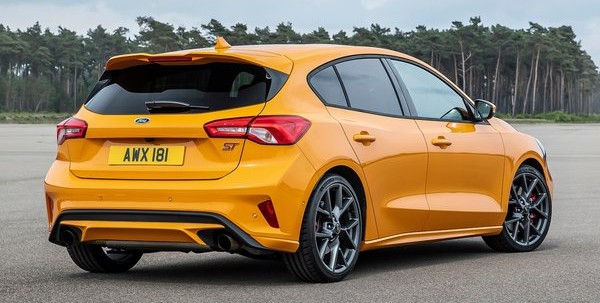
|
|
The
2.3 produces an off-beat exhaust like a 5-cylinder engine... or the
speakers?
|
|
The large four produces an off-beat exhaust note like a 5-cylinder
engine, not unlike that of the Volvo-engined Mk2. This probably comes
from the digital synthesizer through audio speakers, but it sounds so
natural that you are difficult to distinguish. When you lift off
between gearshifts, the exhaust emits pops and bangs for extra thrills.
You can opt for a 7-speed automatic transmission, but no keen drivers
would do so. Most will stick with the 6-speed manual whose gearshift is
slick and its throw short, if not as precise and mechanical as Honda’s.
By the way, Ford also offers a 190hp diesel-powered ST as well as an
estate version to broaden its market appeal, but again keen drivers
should stick with the petrol hatchback.
For the first time, the ST is equipped with an electronic-controlled,
hydraulic-actuated LSD at the front axle, just like the last Golf GTI
Performance, although it is supplied by GKN instead of Borg
Warner/Haldex. This should improve its front-end bite and reduce
understeer. The ST’s suspension is beefed up mildly. Spring
rates are unchanged from the lesser Focus ST-Line with double-wishbone
rear suspensions, but front and rear dampers are stiffened by 20% and
13%,
respectively. Ride height is dropped by 10mm, accompanied with stiffer
bushings and thicker anti-roll bars. Continuous adaptive dampers are
added to the car for the first time. It also wears grippier Michelin
Pilot Sport 4S tires. Meanwhile, the brakes have been upgraded to 330mm
and 302mm discs front and rear, respectively. They are now served with
electrohydraulic booster, thus the brake pressure can be adjusted
automatically to compensate brake fade.
A more important change is probably the electric power steering. Its
ratio has been tightened by 15%, reducing to only 2.0 turns from lock
to lock. Moreover, the steering knuckle geometry has been revised to
improve feel, while the electric assistance software is updated to
counteract torque steer. Lastly but not least, the new ST is added with
selectable drive modes for the first time. You can switch among
Comfort, Normal, Sport and, should you opt for performance package,
Track mode. The latter adds launch control and allows you to change the
damper setting individually.
Inside, the most significant upgrade is the new Recaro bucket seats.
Unfortunately, the uninspiring and cheap-looking dashboard is unaltered.
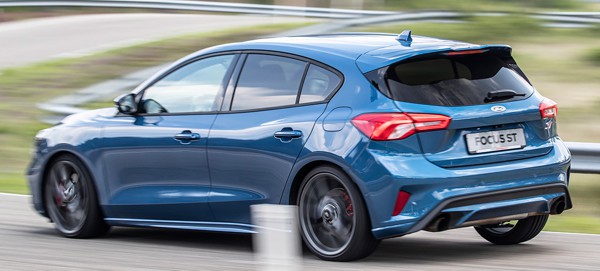
|
|
Agility
and throttle steer are the biggest assets of Focus ST.
|
|
On the road, the first thing you notice is the ultra-quick steering
response. Very much like a Ferrari’s helm, it is shockingly direct,
almost nervous and take some time to get used to.
Once you do, you will find it handy to attack tight corners. It gives
the car a very agile feel. Nevertheless, the ultra-quick helm could
feel also a bit artificial. Its response is the quickest just off
center, and the self-centering is so strong that feels springy. Honda’s
steering feels more linear and more natural.
However, the Focus still handles like a Focus. Thanks to beefy tires
and the electronic differential, it offers impressive front-end bite,
allowing you to keep pushing hard through corners, yet its chassis is
still highly adjustable. It is willing to oversteer on lift-off
throttle, tucks its nose in and moves its tail out controllably,
something difficult to achieve on its main rivals. While
body control is not quite as tight as the stiffly-sprung Megane RS
Cup/Trophy or Civic, and its high-speed stability is no match for the
wing-obsessed
Type R, the Focus feels at home on a B-road. Its suspension is firm but
not overly firm, with just the right level of bump absorption without
showing too much body movement. Its quick steering works best on a
winding road. Its brakes never fade. In short, it is
confidence-inspiring to drive fast, to attack your favourite mountain
roads.
On a fast track, its handling is less remarkable. Braking into a fast
bend reveals more pitch and lean than its main rivals, probably due to
its heavier engine and the lack of downforce. As a result, the Focus ST
is not quite as sharp at the limit. It is more suitable to a B-road,
where its superior agility and adjustability excel.
However, the ST is still quite a long way behind Civic Type R for
driving satisfaction. Its engine is less enthusiastic to rev, its
gearchange is slightly less polished, its body control is not as good,
stability is not as high and its ride is not as composed. That’s why
the Type R is in another league. Meanwhile, Renault Megane RS Trophy is
also flatter and faster in corner, but it loses to Ford in tactile
controls and powertrain. However, the Focus ST is easier to live with
than both on daily basis. Its cabin is not as noisy as Honda, and
visibility is not hampered by big wings. It rides far more comfortable
than the Renault. Until Volkswagen introduces a new Golf R, the Focus
ST is the definitive choice for those chasing driving fun without
sacrificing practicality.
|
Verdict:    
|
|